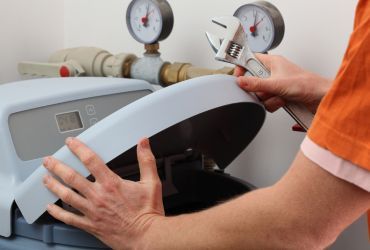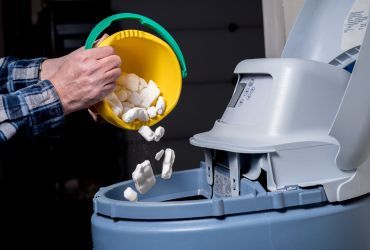Why Is My Water Softener Not Working Properly?
If your water softener isn’t working properly, it could be due to salt build-up, mechanical malfunctions, or improper maintenance. A faulty water softener can lead to hard water that negatively affects your home, including your carpets, appliances, and plumbing. Identifying these problems early helps ensure soft water, which is vital for effective cleaning and maintaining a healthier home.
Water softeners are an essential part of many households, particularly in areas with hard water. These systems treat water by removing hard minerals like calcium and magnesium, ensuring better water quality. However, when a water softener malfunctions, it can lead to a cascade of issues, including mineral buildup on surfaces, increased wear on carpets, and reduced cleaning efficiency.
Common Reasons Your Water Softener Is Malfunctioning
1. Salt Bridges and Salt Mushing
Salt buildup in the brine tank is a frequent cause of water softener failure. Salt bridges occur when salt hardens into a crust, creating a gap between the salt and water in the brine tank. This prevents the salt from dissolving into a brine solution, essential for regeneration cycles. Similarly, salt mushing happens when dissolved salt recrystallizes at the bottom of the tank, forming a sludge-like layer that blocks proper flow. Both issues lead to insufficient regeneration, leaving hard minerals in your water supply.
Solution: Regularly inspect your brine tank for hardened salt. To fix salt bridges, carefully break up the crust using a long tool like a broom handle. For mushing, completely empty the tank, clean it thoroughly and refill it with fresh, high-quality evaporated or pellet salt. Prevent future buildup by maintaining proper salt levels and using purer forms of salt designed for water softeners.
2. Resin Bead Wear and Tear
Resin beads are responsible for the critical ion exchange process that removes hard minerals like calcium and magnesium from water. Over time, these beads degrade due to constant use, exposure to iron, and chlorine in the water. Worn-out resin beads can no longer trap minerals effectively, leading to hard water passing through the system. You might notice increased mineral scaling on appliances, reduced cleaning efficiency, or a change in water taste and feel.
Resin beads typically last 5–10 years but may need replacement sooner if you have high levels of chlorine or iron in your water. Regular maintenance, including flushing the resin bed with a resin cleaner, can extend their lifespan. When replacing the resin, ensure you use high-quality beads to maximize efficiency. Professional services, like those from Cummings Plumbing, can help assess resin wear and replace beads to restore optimal system performance.
3. Clogged Venturi Valve or Injector
The venturi valve and injector play a vital role in the regeneration process by creating suction to draw brine into the resin tank. Mineral deposits, sediment, or debris from unfiltered water can clog these components, hindering proper flow. When this happens, your water softener cannot regenerate effectively, resulting in hard water bypassing the system. A clogged venturi valve often leads to visible signs like cloudy water or white spots on dishes and fixtures.
Tip: Disassembling and cleaning the venturi valve is essential to keep your water softener running smoothly. Use warm, soapy water and a soft brush to remove any buildup. Pay close attention to small openings that can easily become clogged. Regular cleaning every few months prevents debris accumulation and ensures consistent performance. If clogs persist, consult a professional like Cummings Plumbing to inspect and service the valve.
4. Electrical or Programming Issues
Modern water softeners rely on electrical controls and programmable timers to run regeneration cycles. A power outage, surge, or incorrect programming can disrupt these cycles, causing your system to malfunction. You might find that the water softener skips regeneration entirely, or it regenerates too frequently, wasting salt and water. Incorrect settings can also lead to an undersized system struggling to handle your household’s water needs.
Solution: Start by checking the control panel for error codes or blinking lights, which can indicate specific issues. Reset the system according to the manufacturer’s instructions, ensuring the timer is set based on your household’s water usage patterns. For households with high water consumption, program regeneration cycles to run more frequently. If the control panel malfunctions or fails to respond, replacing it may be necessary. Professional technicians, like those at Cummings Plumbing, can diagnose electrical issues and recalibrate your system to ensure optimal performance.
How Does a Faulty Water Softener Affect Carpet Cleaning?
A malfunctioning water softener significantly impacts the results of carpet cleaning. Hard water contains minerals that can interfere with cleaning agents, reducing their effectiveness. Here’s how:
- Residue and Stains: Hard water leaves mineral deposits on carpets, leading to visible streaks or stains after cleaning.
- Soap Inefficiency: Cleaning solutions may not foam or rinse properly, resulting in residue buildup.
- Fiber Damage: The abrasive nature of hard water minerals can damage carpet fibers, making them stiff and dull over time.
Soft water, on the other hand, enhances cleaning effectiveness by allowing detergents to work better and rinse away more thoroughly. This helps prolong the life of carpets and keeps them looking fresh and soft.
Additional Causes for Water Softener Failure
1. Overloading the System
Using more water than the system’s capacity can overwhelm the water softener. This often happens in large households or during periods of high water usage.
Fix:
Check your system’s capacity and ensure it matches your household needs. For frequent overloading, consider upgrading to a larger unit.
2. Dirty Brine Tank
A neglected brine tank can accumulate sludge and dirt, reducing its ability to produce the brine necessary for ion exchange.
Maintenance Tip:
According to Cummings Plumbing, clean the brine tank at least once a year. This includes removing old salt, scrubbing the tank, and refilling it with fresh salt.
Tips to Maintain Your Water Softener
Proper maintenance ensures your water softener works efficiently for years. Follow these steps:
- Test Water Hardness Monthly:
Use a water hardness test kit to ensure your softener is working correctly. Adjust the settings if needed. - Inspect Salt Levels:
Check salt levels regularly and add salt before the tank runs out. Keeping the salt level halfway full is ideal. - Flush the Resin Bed:
Some water softeners have a resin bed cleaning cycle. Use it periodically to remove buildup and extend resin life. - Schedule Professional Servicing:
Experts like Cummings Plumbing can perform thorough inspections, clean essential components, and address any mechanical or programming issues. - Use High-Quality Salt:
Low-quality salts often contain impurities that contribute to sludge buildup. Opt for evaporated salt pellets for cleaner, more efficient operation.
Final Thoughts
A properly functioning water softener is key to maintaining water quality in your home. From preventing hard water damage to ensuring better carpet cleaning results, regular maintenance, and timely troubleshooting can save you from costly repairs and replacements.
If you notice your water softener isn’t working properly, address the issues promptly or reach out to Cummings Plumbing for professional help. Their team of experts can diagnose problems and restore your system, ensuring your home benefits from clean, soft water.
FAQs
How do I know if my water softener isn’t working?
Signs that you need water softener maintenance include increased hard water stains, stiff laundry, and reduced soap lathering. You may also notice scaling on faucets or pipes.
Can I troubleshoot a water softener myself?
Yes, you can address minor issues like salt bridges or cleaning the brine tank. However, professional servicing like Cummings Plumbing is recommended for complex problems like resin bead replacement or valve repairs.
How often should a water softener regenerate?
This depends on your household water usage. Most systems regenerate every 2–3 days, but high-usage households may require daily cycles. Contact us to learn more.


